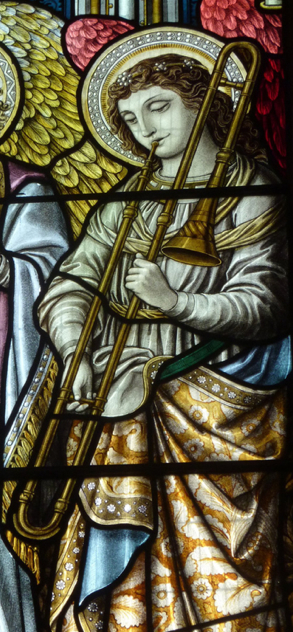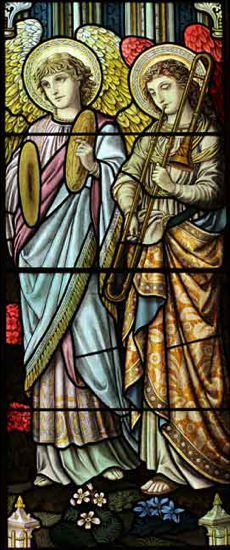Several months ago I posted Canvas, Paper, Silver, and Glass: St. Cecilia Trombone Image in Many Forms, which included a trombone image in painted glass. Trombone images of this type seem to be relatively rare, but last week I added a stained-glass image from the small English village of Booton (Norfolk) to the Trombone History Timeline (19th century). Here it is, below, along with the timeline entry and a more detailed image of the trombone.
1891—Booton, Norfolk, England: The rebuild of St. Michael and All Angels church is completed. One of the nave windows, completed by Alex Booker, includes a depiction of angels playing cymbals and trombone (see detail and full image below; public domain) (Wilson, North East Norfolk and Norwich: Norfolk 1, 409).

David Guion
Very interesting. It does not look like a 19th-century image. The shape and decoration of the trombone, the foreshortened slide, and the way the angel holds it all suggest the 16th century. Is Booker’s work a replica of the original window? Or did he copy from an earlier painting? It is obviously not modeled on any trombones or trombonists he could have ever seen among his contemporaries!
wkimball
I kind of thought the same thing. Here’s a link to a site on Norfolk Stained Glass describing the church.
The extensive redesign was done by the Reverend Whitwell Elwin without the aid of an architect. According to the stained-glass site, “Elwin ‘borrowed’ a vast number of details from other churches across the country e.g. the west window was influenced by St Stephens Chapel. Westminster, however, the slender twin towers and the central pinnacle are believed to have been designed by Elwin himself. As a result the church is best described as a ‘gothic fantasy.'” He could very well have “borrowed” the images of the instruments from an existing image, although the angels themselves are said to be “blessed girls” from Elwin’s congregation (see following).
The stained-glass site also provides some information specifically about the windows: “All the windows contain stained glass of the period (or possibly a little later) and add much to the ambience of the building. In deference to the church’s dedication, all depict representations of angels, many of which are said to have been portraits of ‘blessed girls’ with whom Elwin was an ‘affectionate, almost intimate counsellor’ – as you can see they are beautiful individually and en masse create a stunning group. David King believes that although the designer of the scheme ‘started by imagining a strictly biblical or theological arrangement he soon became carried away on flights of iconographical fancy.’ The scheme itself was started by Cox, Sons and Buckley assisted by the glaziers Purchase and Booker. Subsequently Alex Booker was responsible for designing a number of the windows in particular those in the nave.”
Alex Booker was from London and split his career between London and Bruges.
Major Gerlock
Thanks for providing such information.